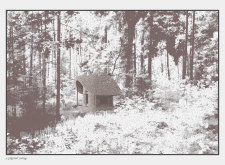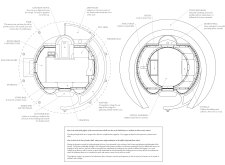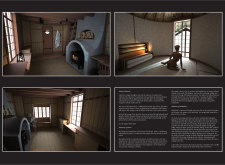5 key facts about this project
The design of “A Pilgrim’s Cottage” incorporates a unique organic form that seamlessly aligns with the surrounding topography. This intentional curvature of the structure serves to envelop occupants in comfort, promoting a sense of safety and security. The building operates primarily in a circular layout, allowing for fluid movement and interaction within the space while enhancing the feeling of unity with the ecosystem. The arrangement encourages various uses—from settings for quiet reflection to spaces for light socialization—adapting to the needs of its inhabitants.
A close examination of the materials employed reveals a commitment to sustainability and environmental responsiveness, which is a hallmark of modern architectural practice. The use of wood frame construction provides both structural integrity and warmth, while the board and batten walls add to the rustic aesthetic and durable quality of the cottage. The inclusion of a cast iron stove at the heart of the cottage acts not only as a source of heat but as a focal point, inviting occupants to gather in the hearth-like space. A thatched roof further exemplifies the design's dedication to traditional craftsmanship while also serving functional insulation purposes.
The architectural design also carefully considers the relationship between the interior and exterior spaces. Large windows serve as portals, framing views of the encircling forest while blurring the barriers between outside and inside. This approach heightens the sense of immersion in nature, allowing sunlight to filter gently into the living areas, further enhancing the meditative ambiance. A noteworthy inclusion within the interior is the emphasis on simple, natural materials that heighten the sensory experience, creating a space that feels both comforting and alive.
Critical details throughout the cottage reflect a nuanced understanding of both human and environmental needs. The integration of planter boxes with the exterior elements softens the building's edges, facilitating a dialogue with the surrounding foliage. Interior features, such as window seats and multifunctional desks, invite prolonged engagement with the space, encouraging occupants to connect with their thoughts in an intimate setting. The design also acknowledges practical necessities, incorporating elements such as a dry toilet and built-in storage that align with sustainable living practices.
What truly distinguishes “A Pilgrim’s Cottage” is its philosophical underpinning, emphasizing the significance of human connections to the natural world. Each design decision reflects a careful consideration of how architecture can influence well-being and foster a deeper appreciation for solitude. The project exemplifies a commitment to creating spaces that resonate with personal experiences and emotional needs, showcasing how these elements can be woven seamlessly into architectural endeavors.
For those interested in delving deeper into the architectural plans, sections, and innovative design ideas that make this cottage unique, exploring visual presentations and detailed insights can provide further clarity. This project serves as an invitation to reflect on the broader implications of architecture in enhancing our relationships with both space and nature.


























